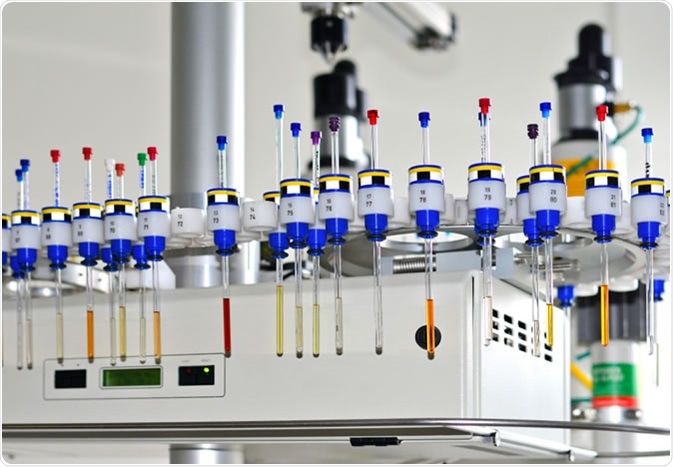Skip to:
X-ray crystallography and nuclear magnetic resonance (NMR) spectroscopy are two techniques used to study atomic structures.
.jpg)
X-Ray crystallography scientific equipment used to resolve three-dimensional structure of biological molecules such as proteins and DNA - Image Credit: Gregory A. Pozhvanov / Shutterstock
The main difference between these tools is that X-ray crystallography uses X-rays to determine the three-dimensional structure of a crystal, whereas NMR spectroscopy uses strong local magnetic fields to analyze the alignment of nuclei in an atom.

Autosampler of NMR spectrometer loaded with samples for analysis. Image Credit: Smereka / Shutterstock
Although different, X-ray crystallography and NMR spectroscopy are considered complementary techniques. The degree to which they complement each other, however, has long been debated in scientific community. For example, does crystallography provide better structural resolution than spectroscopy? Do proteins that are amenable to NMR analysis of their structure crystallize well?
Each technique excels where the other does not, meaning that they are extremely complementary as spectroscopic methods of high-resolution analysis of protein structure and function.
Below is a brief comparison of the two techniques, and their strengths and weaknesses.
Advantages of X-ray Crystallography vs. NMR Spectroscopy
Advantages of X-ray crystallography include:
- X-Ray crystallography provides a two-dimensional view that gives an indication of the three-dimensional structure of a material
- Relatively cheap and simple
- Useful for large structures: Not limited by size or atomic weight.
- Can yield high atomic resolution.
Advantages of NMR spectroscopy include:
- Dynamic technique
- Non-destructive and non-invasive
- Three-dimensional structures in their natural state can be measured directly in solution
- Can provide unique insights into dynamics and intramolecular interactions.
- Macromolecular three-dimensional structure resolution can be as low as sub nanometer.
Disadvantages of X-ray Crystallography and NMR Spectroscopy
Disadvantages of X-ray crystallography include:
- The sample must be crystallizable
- The types of sample that can be analyzed are limited. In particular, membrane proteins and large molecules are difficult to crystallize, due to their large molecular weight and relatively poor solubility
- An organized single crystal must be obtained to produce the desired diffraction
- Non-dynamic method due to preparation of samples and crystallization. Only a static three-dimensional analysis is produced
- X-Ray crystallography has limited applications for studies of biological samples due to the aforementioned issues.
Disadvantages of NMR Spectroscopy include:
- The application of NMR in large biomolecule analysis is limited by the complication and difficulty of interpretation of biomolecules with large molecular weight
- Large amounts of pure samples are needed to achieve an acceptable signal to noise level
- Highly sensitive to motion. This can lead to signal distortions in artifacts
- The high-magnetic field can cause problems with other equipment in a laboratory. Therefore, extra precautions may need to be taken, especially if working space is limited.
For atomic and protein analysis, X-ray crystallography and NMR spectroscopy represent two of the best methods available. This article has been a brief introduction to the advantages and disadvantages of these complementary methods.
Further Reading
Last Updated: Oct 30, 2019